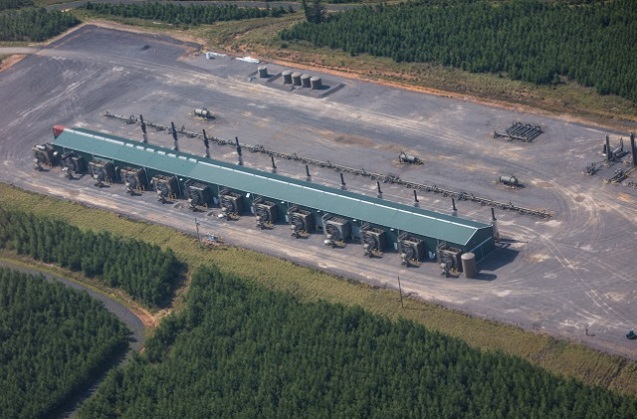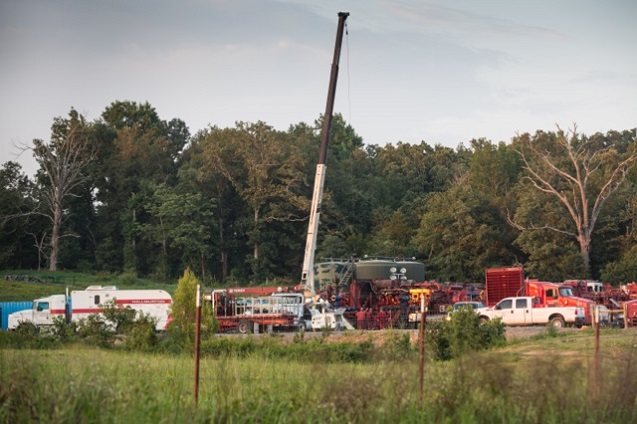
Results from air samples taken in the Fayetteville Shale show notably elevated levels of formaldehyde, a suspected human carcinogen that can cause respiratory and reproductive problems as well as birth defects — but citizens still have little faith U.S. regulators will step in to prevent further threats to human health.
The tests were conducted by an Arkansas community group trained by Global Community Monitor to use equipment and methods certified by federal agencies to collect the air samples. Citizen groups in Colorado, New York, Ohio, Pennsylvania and Wyoming were also trained for the community-based participatory research.
Over a period of two years, samples were taken at sites locals were concerned about. Laboratory analysis of the samples collected often revealed contaminants such as benzene, formaldehyde and other toxic substances above levels the federal government considers safe for brief or longer-term human exposure.
“The implications for health effects are just enormous,” David O. Carpenter, director of the University at Albany’s Institute for Health and the Environment, told National Geographic.
Carpenter was lead author on a peer-reviewed article published on Oct. 30 in tandem with Coming Clean and Global Community Monitor’s study, “Warning Signs: Toxic Air Pollution Identified at Oil and Gas Sites.”
 Compressor station in Fayetteville shale region. ©2104 Julie Dermansky for Oceans 8 Films.
Compressor station in Fayetteville shale region. ©2104 Julie Dermansky for Oceans 8 Films.
Emily Lane, director of ArkansasFracking.org, spoke at briefings with the Environmental Protection Agency (EPA) on November 20 in Washington, DC, to share the results of air quality tests.
“We have worked for over two years gathering this air data, solidifying a foundation to our research that goes beyond the anecdotal,” Lane told DeSmogBlog. “We did what we could do to take action into our own hands. Now it’s left to our public officials to respond to our pleas for help,” she said.
The meeting with the EPA was followed by a congressional briefing on the study.
 Emily Lane at a compressor station where she collected multiple air samples. ©2104 Julie Dermansky for Oceans 8 Films.
Emily Lane at a compressor station where she collected multiple air samples. ©2104 Julie Dermansky for Oceans 8 Films.
Lane collected air samples for the study in and around her hometown of Greenbrier, Arkansas. A rural community north of Little Rock, Greenbrier sits atop the Fayetteville Shale where the fracking industry started booming in 2009.
Area residents began to experience earthquakes likely caused by wastewater injection wells, air pollution, heightened noise pollution, traffic accidents and damaged roads from heavy industry trucks.
“Decision- and policy-makers need to hear from community members,” Jessica Ennis of Earthjustice, who facilitated the meetings, told DeSmogBlog. “And now they have.”
At the briefing with the EPA, the agency staff commended the citizens’ group for the work it had done, and talked about a desire to make things better. However, facing the wrath of the incoming Republican-led Congress, it is unclear what the EPA could do in this situation, facing its own funding challenges.
When asked last year to define the EPA’s role in defending the public from the fracking industry when state agencies fail to do so, David Broomgren, former senior advisor for public affairs representative for the EPA, gave DeSmogBlog an official, “No comment.” (He now works at PR company Hill & Knowlton.)
The Halliburton Loophole, which exempts the fracking industry from the Safe Drinking Water Act, coupled with the Obama Administration’s “all of the above” energy stance that sees natural gas extraction as part of the path to energy independence, potentially hinder the EPA’s regulatory powers.
A day after the meeting, the EPA released new rules on greenhouse gas reporting for the oil and gas sector. But these rules don’t change how the sites monitored in the report have to operate.
Emily Harris, a public health facilitator and an executive board member of the Faulkner County Concerned Citizens Advisory Group, participated in taking air samples for the report and attended the EPA meeting.
Despite the report’s findings and having the ear of the EPA, Harris doesn’t expect anything to change soon in light of the mid-term election results.
 Emily Harris at a Southwest Energy natural gas station in Conway, Arkansas. ©2104 Julie Dermansky for Oceans 8 Films.
Emily Harris at a Southwest Energy natural gas station in Conway, Arkansas. ©2104 Julie Dermansky for Oceans 8 Films.
She invited Arkansas State representatives to the congressional briefing by phone and e-mail. None of her state representatives showed up, nor did any members of their staff.
“Policymakers’ ability to effectively deal with pollution are limited in this political environment — now worse then ever. The folks that are supposed to be protecting us aren’t,” she told DeSmogBlog .
The study results didn’t surprise Dirk DeTurck, a member of the Faulkner County Concerned Citizens Advisory Group in Arkansas. His personal experience proved to him already that the fracking industry’s fumes were bad for his family’s health.
Shortly after the fracking began he and his family developed a range of health issues they didn’t have before, including rashes and respiratory problems.
He sold his home at a sizable loss, relocated his family away from the center of the fracking activity. After relocating, their health began to improve quickly.
 Dirk DeTurck at a fracking industry site in Faulkner County. ©2104 Julie Dermansky for Oceans 8 Films.
Dirk DeTurck at a fracking industry site in Faulkner County. ©2104 Julie Dermansky for Oceans 8 Films.
Instead of suing and settling with industry as some of his neighbors did, DeTurck swallowed his loss to get out. Signing a non-disclosure agreement, which most of those who settle with industry have to do, was not something he considered.
Industry couldn’t pay DeTurck to be silent. He remains an outspoken critic of the fracking industry and directs those interested in learning more to the most toxic sites, some of which he visited to take air samples for the study.
The Fayetteville Shale, one of America’s top seven gas shale plays, peaked in 2012 and is now in decline, according to the Post Carbon Institute (PCI) report, “Drilling Deeper: A Reality Check on U.S. Government Forecasts for a Lasting Tight Oil & Shale Gas Boom.”
“You don’t need a study to see the area is in decline.” DeTurck says. Some people who made money by leasing their land to the fracking industry bought larger homes and fancy vehicles. They have since gone bankrupt and had their homes foreclosed on, DeTurck points out. It was clear to him a couple of years after the boom began that the promise of a 100-year supply of natural gas was a fantasy.
 Halliburton frack site in Greenbrier, Arkansas. ©2104 Julie Dermansky for Oceans 8 Films.
Halliburton frack site in Greenbrier, Arkansas. ©2104 Julie Dermansky for Oceans 8 Films.
Despite the decline in gas production, the fracking industry is still drilling new sites in the area. And if the export rules change for natural gas, the price of natural gas will go up, according to the U.S. Energy Information Administration. Increased prices for natural gas will make it more feasible for the fracking industry to continue to expand fracking operations despite diminishing returns.
Like Emily Harris, DeTurck doesn’t believe anything will change any time soon.
He points to representatives from industry who discredited the report shortly after it was released, saying the samples weren’t done right.
“They do this with all the proof presented in scientific studies that cast a negative light on the industry.”
“Industry and legislators using the job card all the time really pisses me off,” DeTurck says. “The money coming in from the fracking industry only lines the politician’s pockets. It does nothing for the people who live here.”
He has a warning for communities where fracking is threatening to begin:
“Industry comes, fracks you and leaves. You are the one who is going to be sick. They don’t care. They are gone. Fight back while you still can.”
Matching Opportunity Extended: Please support Truthout today!
Our end-of-year fundraiser is over, but our donation matching opportunity has been extended! Today, all donations to Truthout will be matched dollar for dollar. Your one-time gift today will be matched immediately. As well, your monthly donation will be matched for the whole first year, doubling your impact.
This matching gift comes at a critical time. Trump has made it no secret that he is planning a demolition-style attack on both specific communities and democracy as a whole, beginning on his first day in office.
Help us prepare for Trump’s Day One, and have your donation matched today!